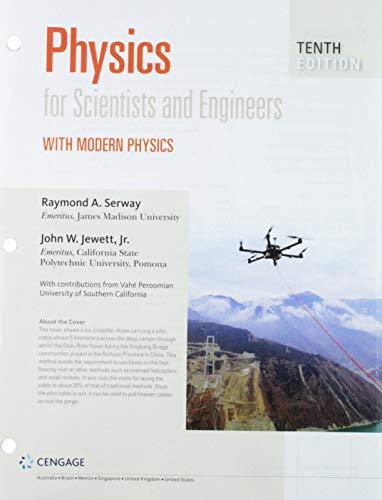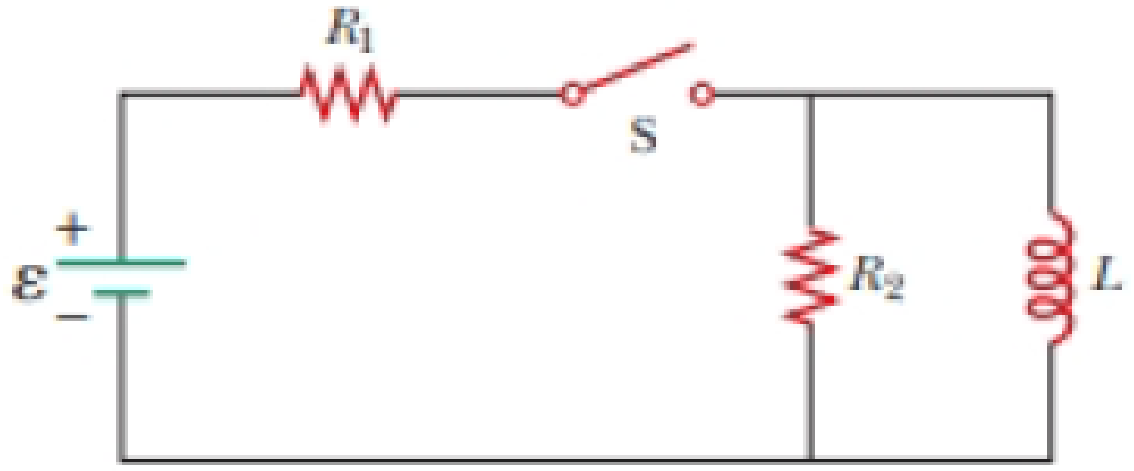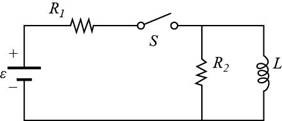
At t = 0, the open switch in Figure P31.46 is thrown closed. We wish to find a symbolic expression for the current in the inductor for time t > 0. Let this current be called i and choose it to be downward in the inductor in Figure P31.46. Identify i1 as the current to the right through R1 and i2 as the current downward through R2. (a) Use Kirchhoff’s junction rule to find a relation among the three currents. (b) Use Kirchhoff’s loop rule around the left loop to find another relationship. (c) Use Kirchhoff’s loop rule around the outer loop to find a third relationship. (d) Eliminate i1 and i2 among the three equations to find an equation involving only the current i. (e) Compare the equation in part (d) with Equation 31.6 in the text. Use this comparison to rewrite Equation 31.7 in the text for the situation in this problem and show that
where R′ = R1R2/(R1 + R2).
Figure P31.46

(a)
The relation among the three currents by Kirchhoff’s junction rule.
Answer to Problem 46AP
The relation among the three currents by Kirchhoff’s junction rule are
Explanation of Solution
Given info: The figure that shows the given circuit is shown below.

Figure (I)
According to Kirchhoff’s junction rule, the total incoming currents are equal to the total outgoing currents at a junction.
From the circuit diagram equating the incoming currents to the outgoing current,
Here,
Conclusion:
Therefore, the relation among three currents by Kirchhoff’s junction rule are
(b)
The relationship between the given variables around the left loop by Kirchhoff’s loop rule.
Answer to Problem 46AP
The relationship between the given variables around the left loop by Kirchhoff’s loop rule is
Explanation of Solution
Given info: The figure that shows the given circuit is shown in figure (I).
According to Kirchhoff’s loop rule, the sum of all the voltage across all the elements in a loop must be zero.
From the circuit diagram equating the voltage across the elements in the left loop is equal to zero.
Here,
Conclusion:
Therefore, the relationship between the given variables around the left loop by Kirchhoff’s loop rule is
(c)
The relationship between the given variables around the outer loop by Kirchhoff’s loop rule.
Answer to Problem 46AP
The relationship between the given variables around the outer loop by Kirchhoff’s loop rule is
Explanation of Solution
Given info: The figure that shows the given circuit is shown in figure (I).
According to Kirchhoff’s loop rule, the sum of all the voltage across all the elements in a loop must be zero.
From the circuit diagram equating the voltage across the elements in the outer loop is equal to zero.
Conclusion:
Therefore, the relationship between the given variables around the outer loop by Kirchhoff’s loop rule is
(d)
The equation that involve only current
Answer to Problem 46AP
The equation that involve only current
Explanation of Solution
Given info: The figure that shows the given circuit is shown in figure (I).
From equation (1), the expression for the
Substitute
From equation (2), the expression for the
Substitute
Equate equation (3) and equation (4) for
Further solve the above equation,
Assume
Substitute
Thus, the require equation in term of current
Conclusion:
Therefore, the equation that involve only current
(e)
The comparison of equation for part (d) with the equation
Answer to Problem 46AP
The equation
Explanation of Solution
From the textbook the equation
From the part (d), the equation is given as,
Since both the equation shown above are same therefore their solution are also same.
The solution of the equation
Similarly rewrite the equation
Substitute
Conclusion:
Therefore, the equation
Want to see more full solutions like this?
Chapter 31 Solutions
Bundle: Physics For Scientists And Engineers With Modern Physics, Loose-leaf Version, 10th + Webassign Printed Access Card For Serway/jewett's Physics For Scientists And Engineers, 10th, Single-term
- A high energy pulsed laser emits 1.5 nano second-long pulse of average power 1.80x10" W. The beam is cylindrical with 2.00 mm in radius. Determine the rms value of the B-field? -Tarrow_forwardA 23.0-mw (mill:-Watts) laser puts out a narrow cyclindrical beam 50 mm in diameter. What is the average N/C. rms E-field?arrow_forwardThe average intensity of light emerging from a polarizing sheet is. 0.550 W/m², and the average intensity of the horizontally polarized light incident on the sheet is 0.940 W/m². Determine the angle that the transmission axis of the polarizing sheet makes with the horizontalarrow_forward
- we measure an At a particular moment in time and space, electromagnetic wave's electric and magnetic fields. We find the electric field & pointing North and the magnetic field B pointing Down. What is the direction of wave propagation? a. South b. West C. c. Up d. Down e. East f. North.arrow_forwardHello, please help with how to calculate impact velocity and rebound velocity. Thanks!arrow_forwardA object of mass 3.00 kg is subject to a force FX that varies with position as in the figure below. Fx (N) 4 3 2 1 x(m) 2 4 6 8 10 12 14 16 18 20 i (a) Find the work done by the force on the object as it moves from x = 0 to x = 5.00 m. J (b) Find the work done by the force on the object as it moves from x = 5.00 m to x = 11.0 m. ] (c) Find the work done by the force on the object as it moves from x = 11.0 m to x = 18.0 m. J (d) If the object has a speed of 0.400 m/s at x = 0, find its speed at x = 5.00 m and its speed at x speed at x = 5.00 m speed at x = 18.0 m m/s m/s = 18.0 m.arrow_forward
- An EL NIÑO usually results in Question 8Select one: a. less rainfall for Australia. b. warmer water in the western Pacific. c. all of the above. d. none of the above. e. more rainfall for South America.arrow_forwardA child's pogo stick (figure below) stores energy in a spring (k = 2.05 × 104 N/m). At position (✗₁ = -0.100 m), the spring compression is a maximum and the child is momentarily at rest. At position ® (x = 0), the spring is relaxed and the child is moving upward. At position child is again momentarily at rest at the top of the jump. Assume that the combined mass of child and pogo stick is 20.0 kg. B A (a) Calculate the total energy of the system if both potential energies are zero at x = 0. (b) Determine X2- m (c) Calculate the speed of the child at x = 0. m/s (d) Determine the value of x for which the kinetic energy of the system is a maximum. mm (e) Obtain the child's maximum upward speed. m/s thearrow_forwardAn EL NIÑO usually results in Question 8Select one: a. less rainfall for Australia. b. warmer water in the western Pacific. c. all of the above. d. none of the above. e. more rainfall for South America.arrow_forward
- Earth’s mantle is Question 12Select one: a. Solid b. Liquid c. Metallic d. very dense gasarrow_forwardSilicates Question 18Select one: a. All of these b. Are minerals c. Consist of tetrahedra d. Contain silicon and oxygenarrow_forwardWhich of the following is not one of the major types of metamorphism? Question 20Select one: a. Fold b. Contact c. Regional d. Sheararrow_forward
 Principles of Physics: A Calculus-Based TextPhysicsISBN:9781133104261Author:Raymond A. Serway, John W. JewettPublisher:Cengage Learning
Principles of Physics: A Calculus-Based TextPhysicsISBN:9781133104261Author:Raymond A. Serway, John W. JewettPublisher:Cengage Learning Physics for Scientists and Engineers: Foundations...PhysicsISBN:9781133939146Author:Katz, Debora M.Publisher:Cengage Learning
Physics for Scientists and Engineers: Foundations...PhysicsISBN:9781133939146Author:Katz, Debora M.Publisher:Cengage Learning Physics for Scientists and Engineers, Technology ...PhysicsISBN:9781305116399Author:Raymond A. Serway, John W. JewettPublisher:Cengage Learning
Physics for Scientists and Engineers, Technology ...PhysicsISBN:9781305116399Author:Raymond A. Serway, John W. JewettPublisher:Cengage Learning Physics for Scientists and EngineersPhysicsISBN:9781337553278Author:Raymond A. Serway, John W. JewettPublisher:Cengage Learning
Physics for Scientists and EngineersPhysicsISBN:9781337553278Author:Raymond A. Serway, John W. JewettPublisher:Cengage Learning Physics for Scientists and Engineers with Modern ...PhysicsISBN:9781337553292Author:Raymond A. Serway, John W. JewettPublisher:Cengage Learning
Physics for Scientists and Engineers with Modern ...PhysicsISBN:9781337553292Author:Raymond A. Serway, John W. JewettPublisher:Cengage Learning





